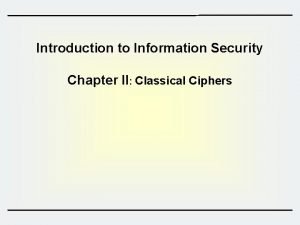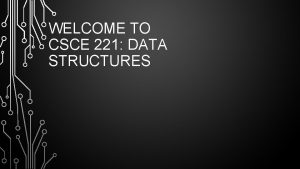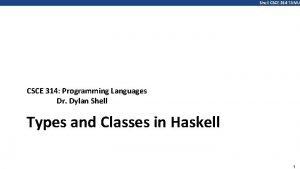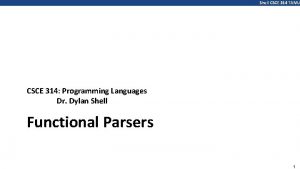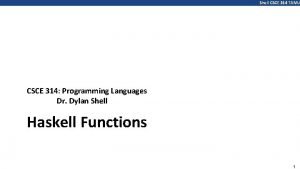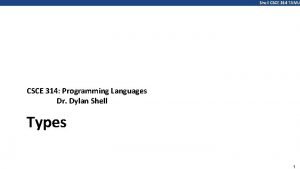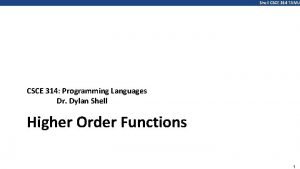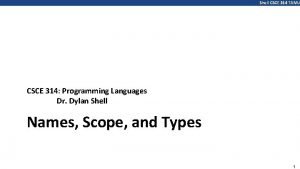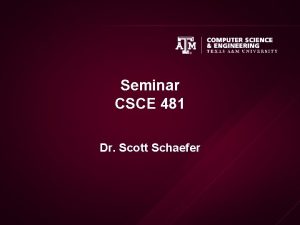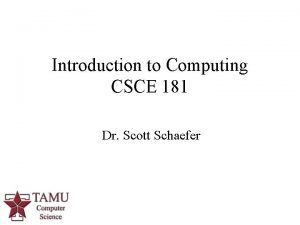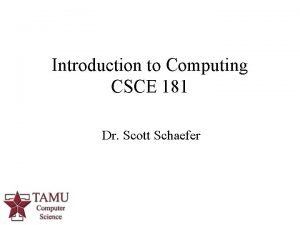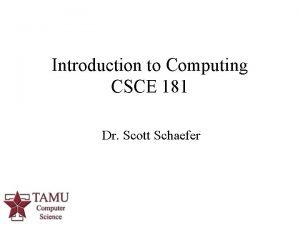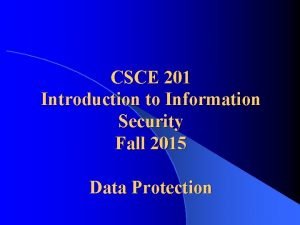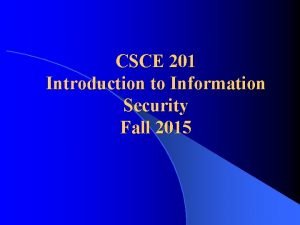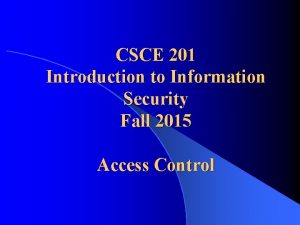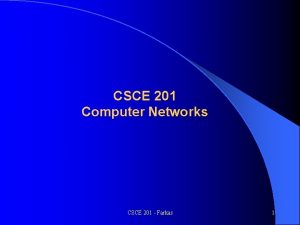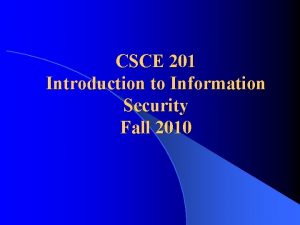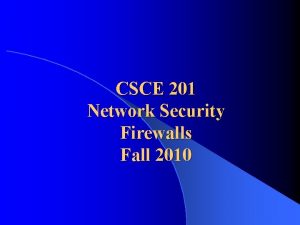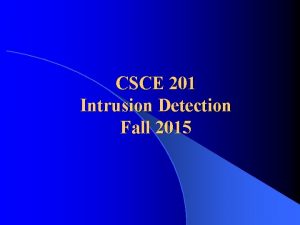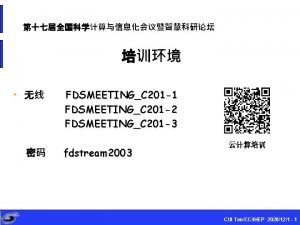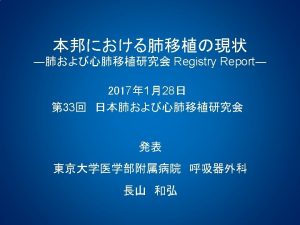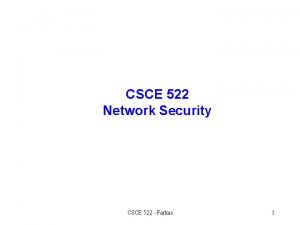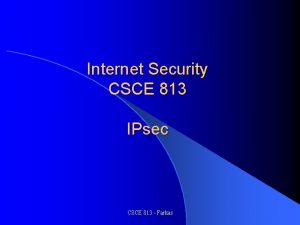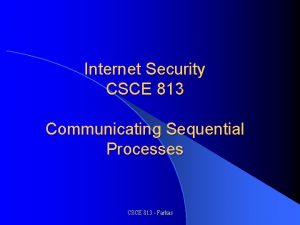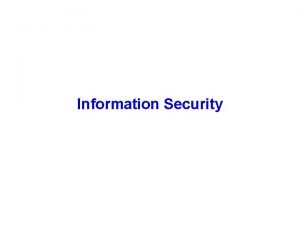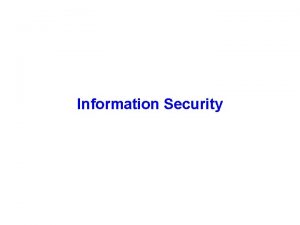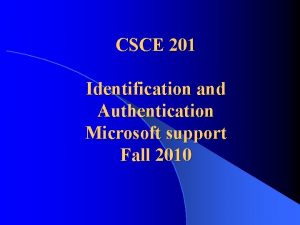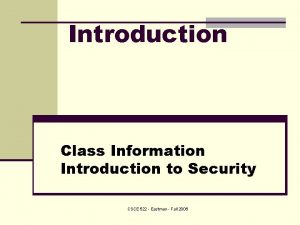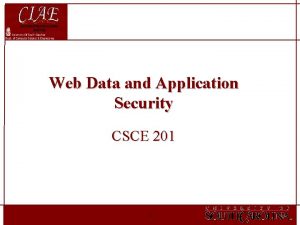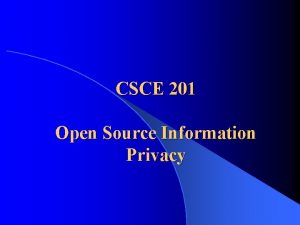CSCE 201 Introduction to Information Security Fall 2015






















- Slides: 22

CSCE 201 Introduction to Information Security Fall 2015 Computer Recovery

Protection of Personal Computers l Security Policy – Formal – Informal l Security Mechanisms – Identification and Authentication – Access Control – Applications and updates – Physical security – Network-level security CSCE 201 - Farkas 2

Protection of Computing Resources l Threats: – – – l Errors of users Natural/man-made/machine disasters Dishonest insider Disgruntled insider Outsiders Etc. Protection against threats – Technical protections – Non-technical protections l Prevent, deter, detect, tolerate, recover CSCE 201 - Farkas 3

Physical Security Protection needs outside the computer system l Direct threats l – Stealing, vandalism, espionage, etc. – Typical protection: guards, locks, fences, etc. l Indirect threats – Natural disaster, electric surge, fire, etc. – Protection: based on type of threat, e. g. , power surge protection, location of computing facility, etc. CSCE 201 - Farkas 4

Natural Disasters l Computer systems – Same vulnerability as homes, cars, etc. – Additional sensitivity: operating environment, e. g. , temperature, humidity, etc. l Vulnerable component: – Hardware devices – Data and software l Goal: reduce the impact of a disaster CSCE 201 - Farkas 5

How to Measure Impact? l Economic impact: – How much does it cost to recover to a pre- attack state? – Cost: replacing hardware/software/data, irreplaceable components, loss of productivity, long term losses, etc. l Personal computer: – Replace hardware – Replace data and applications CSCE 201 - Farkas 6

Replace Damaged Hardware Most computer systems are standard l Ready available supply quick replace l Easily measurable cost of new purchases l Cost balance: – Insurance – Leasing or renting computers and/or facilities CSCE 201 - Farkas 7

Replace Data and In-House Software l Harder to replace if there is no backup l Some data may be lost forever l Application code may not be recoverable or may take a long time to recover l Need backup! CSCE 201 - Farkas 8

Natural Disasters Flood, fire, storms, earthquakes, volcanic eruptions, etc. l Coping with natural disasters: l 1. Developing contingency plans 2. Insuring assets 3. Backups at physically separated safe locations CSCE 201 - Farkas 9

Flood l Time to respond: Depending on the type of flood there may be enough time for orderly shut down and saving the equipment l Losses: hardware, software, data, productivity, etc. l Recovery support: store backup in secure locations CSCE 201 - Farkas 10

Fire Time to respond: requires quick respons l Losses: hardware, software, data, productivity, etc. l – Secondary damage from fire extinguisher (water). New methods: carbon dioxide or gas-based extinguisher l Recovery support: – Fire safety planning of facilities, e. g. , fire resistant doors and walls, control of spreading of smoke and fire – Safety of humans – fire drills – Store backup in secure locations CSCE 201 - Farkas 11

Power Problems l Power Loss – Criticality of the system – Estimated time of loss – Protection: uninterruptible power supply l Power fluctuation – Drops, spikes, surges – Weather conditions (lightning) – Effects all hardware via electric lines, phone and cable connections – Protection: surge protectors, unplug devices CSCE 201 - Farkas 12

Human Vandals and Theft l Physical control of computing systems – No access – Supervised access – Theft protection devices – Self-destroying hardware and application – Etc. CSCE 201 - Farkas 13

Data and Software Protection l Most computing systems (hardware) are easily replaceable l Data and locally developed programs cannot be quickly retrieved from another source l NEED BACKUP CSCE 201 - Farkas 14

Backup Plan Backup: copy of all or part of a file to assist in reestablishing a lost file l Types of backup: l – Complete backup l l Everything on the system is copied Often automated and done at regular intervals – Revolving backup l l Last several backups are kept Avoid problem with corrupted media – Selective backup l l Only files that have changed since the last backup are copied Full backup + selective backup complete record of change CSCE 201 - Farkas 15

Offsite Backup is useless if it is destroyed in the crisis! l Keep backup version separate from actual system l Backup location types: – Networked storage – Cold sites: facility that can accommodate computing centers (need to place hardware and load backups) – Hot sites: computing facility with installed and ready-to-run computing system (need to load backups) l CSCE 201 - Farkas 16

Personal Computer Users l Generally do not make backups l Even minor crises have devastating effects l Need to use available support to create backup – Set intervals for regular backup – Perform backup – Store copies in secure location CSCE 201 - Farkas 17

Personal Computer Backup At home: visit the vendor’s site of your laptop OS, e. g. , for MS Windows: https: //www. microsoft. com/en-us/ and search for instructions for system backup perform a backup of your computer

Decide What to Back Up l All information on this computer ? ? ? – Think twice! – Size of the backup l My documents and settings – Better choice – Limit the amount of data on the backup l Other options – Everyone's documents and settings – Let me choose what to back up -- Items to Back Up CSCE 201 - Farkas 19

Decide Where to Store Your Backup Files l Backup Type, Destination, and Name page: – specify a backup location By default, Backup proposes saving everything to your floppy drive l Best bet is to click Browse and choose any of the following locations l – – Your computer's hard disk Zip drive or other removable media Shared network drive External hard disk drive CSCE 201 - Farkas 20

Set a Schedule—and Stick to It Repeat the above steps once each week and perform regular backups or l Set up an automatic backup schedule for Windows l – Final page of the Backup Wizard – Don't click Finish. Instead, click the Advanced – Click Next to open the When to Back Up page – Choose Later, and then click Set Schedule to open the Schedule Job CSCE 201 - Farkas 21

Next Class l Data Recovery CSCE 201 - Farkas 22
 Private secuirty
Private secuirty Visa international security model diagram
Visa international security model diagram Cnss security model 27 cells example
Cnss security model 27 cells example Scytale
Scytale Osi architecture in network security
Osi architecture in network security Guide to network security
Guide to network security Wireless security in cryptography and network security
Wireless security in cryptography and network security Electronic mail security in network security
Electronic mail security in network security Security policy and integrated security in e-commerce
Security policy and integrated security in e-commerce Seven touchpoints for software security
Seven touchpoints for software security Security guide to network security fundamentals
Security guide to network security fundamentals Security guide to network security fundamentals
Security guide to network security fundamentals Csce 221 tamu syllabus
Csce 221 tamu syllabus Csce 314
Csce 314 Csce 314
Csce 314 Csce 314
Csce 314 Csce 314
Csce 314 Tamu csce 314
Tamu csce 314 Csce 314 tamu
Csce 314 tamu Csce 481 tamu
Csce 481 tamu Csce 181
Csce 181 Csce 181
Csce 181 Csce 181
Csce 181



